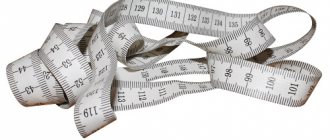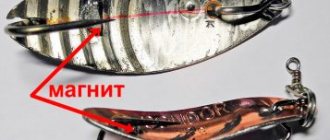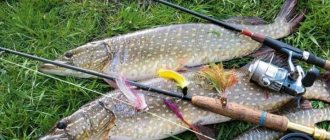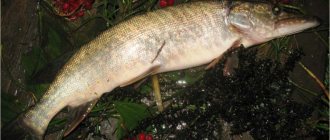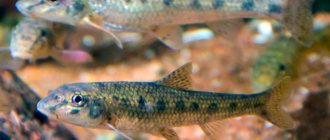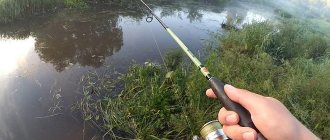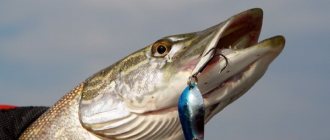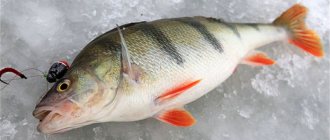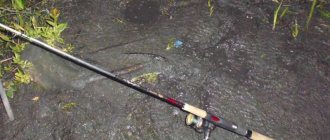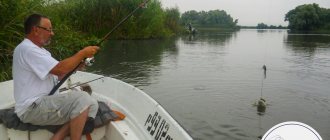Fishing for pike with lures has been known to many fishermen for a very long time; this method is considered one of the oldest. But in today's realities, with the promotion of wobblers, many fishermen refuse to use pieces of iron when fishing, which is not entirely justified.
Fishing for pike with lures has been known to many fishermen for a very long time; this method is considered one of the oldest. But in today's realities, with the promotion of wobblers, many fishermen refuse to use pieces of iron when fishing, which is not entirely justified.
In some situations, a spinner can completely replace a wobbler, and sometimes it even turns out to be much more effective than modern plastic baits. And the low cost of these gears only benefits them.
The variety of spinners for fishing is quite extensive. Some fishing lures are thin and light, others are thick and heavy. Different fishing lures have different actions. How and where you fish will determine the spinner rig you should use.
Basics of wiring spinners for fishing
Fishing spoons have a simple design, an oblong shape, concave on one side, which catches the water, producing an oscillation and a reflective flash that imitates a running or crippled bait fish. Spoons work best for larger species of fish such as pike, pike perch, salmon, trout and of course perch will also not disdain to attack the spoon..
The action of the spoon is based on its shape and thickness. A long spinner will display a wider side to the swing than a shorter spinner. A deep concave spoon will also produce a wider swing than a flatter spoon.
Its main goal is to create an imitation of the movement of a small fish , to which the predator will react. It is not difficult to learn this by trying several options until you select the optimal one for a given reservoir.
When going fishing with a set of spinners and properly selected equipment, you need to know in what places the predator likes to hunt. Therefore, upon arriving at a reservoir, we first look for such places.
Where do pike live?
The favorite places of the toothy predator are fallen trees, mudflats, creeks, reed thickets along the shore, and grass fields. She also likes holes or the bottom where there are differences in depth. During migration, you can catch pike in open water - best in narrowed areas of the river.
Casting
Depending on the fishing method and the reservoir, casting is done. If the river or lake is wide, then to cover a larger fishing area it is better to stick to the fan type of casting. So, step by step you examine the entire water area, leaving no chance for the predator to escape the bait.
On a river where there is a small or strong current, as well as when fishing from a boat, you should cast along the current . From the shore - diagonally. If the bottom is strewn with snags and driftwood, on which the bait can get caught, then there is no need to wait until it falls to the bottom; you should start retrieving the moment the spoon hits the water.
Wiring technique
Wiring technique plays a major role when fishing for pike. If it is done incorrectly, then the chances of successful fishing are reduced significantly.
Its main goal is to create an imitation of the movement of a small fish , to which the predator will react. It is not difficult to learn this by trying several options until you select the optimal one for a given reservoir.
Basically, two types of wiring are used: when the spoon falls to the bottom or as soon as it splashes down. The first can be used if the bottom is clean, without obstacles where the bait could get caught.
When using a “calibrator”, the wiring is done with short pauses every three turns of the coil. The general principle of conducting is reduced to unhurried and uniform wiring.
There are several other methods, the names of which speak for themselves:
- Wavy - the bait is then raised and then lowered.
- Twitching - with even retrieving, a slight twitching of the rod is done so that the lure plays better.
- Stepped - with a pitty bottom, allow the spoon to lie in the recesses, then lift the bait with a slight tug and continue retrieving.
Tips for fisherman: Do-it-yourself fishing rod for trolling in winter - Features of choice
Sweeping
As soon as the pike is hooked, the hook is made quickly and sharply, the rod is lowered to 60–40 degrees to the water to absorb the blows of the fish. In this case, it is necessary to act very quickly, preventing the pike from going into the thickets, where there is a possibility of the fishing line getting tangled and breaking.
Blitz tips:
- When casting, try to create a loud, drawn-out sound of the spinner hitting the water. The predator likes it.
- When you catch the first pike, continue fishing in the same area. Often fish stay in groups of several in one place.
- Pike does not like extraneous noise, so you should remain quiet while fishing.
Listen to the advice of experienced fishermen when fishing for pike with spoons to avoid common mistakes and maximize your catch. If you stick to the basic rules, you can be sure of a pleasant fishing experience.
Having fished the entire sector, I move 15-20 m to the right or left and continue the same sector “shelling”. So I go around the entire area and find all the sharp changes and unevenness of the bottom. During fishing, I return several times to already explored places.
due to low aerodynamic resistance, it flies very far, up to 80 m and beyond; it launches independently in the water, that is, it begins to rotate without additional jerks, only under the weight of the sinker-head descending on the fishing line;
Over time, step retrieving can be diversified by changing the height, length and profile of the bait steps by changing the reel speed of the reel and varying the movement of the spinning rod tip. With such manipulations, you can imitate the different behavior of the fry with a spinner. There is a lot of scope for the imagination of every angler, for mastering his own style of play, unlike others.
When selecting the mass of the spoon for a specific hole, you need to achieve a slow retrieve near the bottom, allowing a pause during which the bait can move in a small step.
Pike fishing
And it all started with a pike. However, it would be surprising if this common predator did not top the list of fish caught on a spinner. In this case, the pike is valuable not so much for its species as for its size. This is the largest predator that I have come across on small rivers. Some specimens of pike were frankly surprising in their size: no, no, and in a series of laces I came across a well-fed specimen weighing two kilograms, or even more. Moreover, I caught the largest Malorechye pikes with fairly small spoons, while “twos” and “threes” brought standard kilos.
In most cases, I was lucky, and the pike did not cut off the spinner hooked without a leash. Hence one more observation - not only does the pike not disdain small spinners weighing about 2 grams, but it also takes them very carefully, catching them at the edge of its mouth.
Good pike were caught in similar places - shallow silted floods with a slow flow. Often in such areas there are perch, which is what I was primarily targeting here. You shouldn’t be afraid of shallow places - pike even go out to hunt in open shallow water with a depth of up to half a meter. Of course, it is better to check such areas in cloudy weather or closer to dusk. Maintaining camouflage when fishing for pike will also not be superfluous.
I also noticed that pike in shallow water are not isolated: with each new visit, you can take a good pike, or even more than one, from one interesting point. Even if there were no pike bites, it is worth visiting the place at another time of day.
In calm waters, casts can be made in different directions - the wiring will be of high quality. But when fishing in the current, I prefer to cast the spinner with the current, and lead it against it. The wiring is done along the shore. This is the most typical scheme for catching pike with a rotating spoon on small rivers. You can move the spoon very slowly, feeling how the petal plays.
It is better to choose relatively deep sections of the river and always with vegetation. It is from this that the pike jumps out behind the spinner. If in shallow reaches it is possible to use small spinners, then heavier ones - weighing up to 10 grams - are better suited for guiding against the current. I often use the “Long” type of petal - its narrow shape allows the spoon to dive deeper.
On the riverbed, casting is also possible perpendicular to the current, but still the vast majority of pike bites for me happened near the shore, more often near the shore, at the end of the retrieve, but sometimes also at the far one - at the very beginning. This is exactly how I caught my first spinning pikes: I cast the spoon to the opposite bank, closer to the vegetation, and at the very beginning of the rotation of the petal several pike bites occurred.
In conclusion of the pike section, I would like to recall interesting cases of catching pike with a rotating spoon. While mastering the river jig, I had a lot of idle bites, when the pike only left teeth marks on the silicone bait, but it was not possible to catch the pike. If the bite location allowed me to use a spinner, then I exchanged the vibrating tail for a spinner and sent it to the same point. Several times I managed to catch an intractable pike this way.
This suggests that a spinner is an easier bait to master, so I always recommend it to beginning spinners. I offered one of my students, who had already had several unsuccessful attempts to catch pike with silicone baits, the proven Lucky John MAL spinner, number 1, weighing 5 grams, silver color. As a result, during one training fishing trip he caught 3 small pike. Moreover, all bites were realized. And in general, derailments from the tee of the turntable happen extremely rarely - most bites happen for sure.
Kolebalka - the queen of spring-summer shallow waters
Here's a puny-looking model (photo above). Material - sheet brass, thickness only 0.5-0.6 mm, length 5.5. cm, width 2.5 cm, weight with tee (or double) about 5 g.
The bait is light and wide, so in flight it sails quite strongly and flies almost like a mosquito thrown by hand. However, if you have a boat and there is no significant headwind or side wind, this is not so significant. I use a light, parabolic, long (2.7 m) rod and thin (0.2 mm) fishing line. I’m perverting for one purpose: to make it possible to throw away this fluff after all.
But after splashdown, such a wobble behaves like a real queen of spring-summer shallow waters. It allows for maximum (literally on the verge of stopping) slow retrieve, while maintaining the ease and naturalness of the game. At such a retrieving speed, the most active wobbler component would become “dead,” and the petal of the most beautiful spinner would begin to “stick.”
The spoon behaves confidently, continuing to play, descending very slowly when stopping, allowing you to fish places with depths of 20-50 cm. And where else but here, at the zenith of the hot May-June days, decent pikes come out, which in no way want to rush to the bait - walkers.
And yet, most spinning anglers prefer mono baits.
- The animation of front-loaded turntables is complemented by micropauses.
- Pike are attracted by a short-term malfunction of the spinner.
- An effective technique would be to touch (strike) the spoon to the bottom.
- Stepped wiring is used when fishing with spoons and jigs.
Rotating spinners
Domestic spinners "Adams" with front loading
A good option for mastering the basics of spinning fishing is a spinner. Fishing with a spinner is quite simple, and even a beginner can easily feel the work of the spinner. With normal, uniform fishing, the spinner produces vibrations that the fish picks up from afar. Depending on the size of the spinner and the depth of the reservoir, the pike “hears” the bait at a distance of 10-20 m.
Among the disadvantages of rotating spinners, it is worth mentioning:
- poor flight characteristics;
- frequent overlaps of the fishing line;
- the use of one or two types of wiring;
- problems with bottom fishing in the current.
Conclusion: don’t skimp on good lures, but at least try the branded version and see the difference.
When pike are active, there are more bites on the spinner than on the spoon. But the size of the fish caught will be slightly smaller.
Tips for fisherman: How to catch perch in winter with a spoon - Choosing the best
The main criterion for a high-quality spinner is the easy rotation of the blade with the slowest retrieve. This bait will interest the most passive pike.
The best turntables are produced by such companies as:
- Mepps;
- Blue Fox;
- Daiwa;
- Myran;
- Cormoran;
- Abu Garcia.
In summer, pike can ignore large spoons. Then you need to switch to turntables No. 1-2 with a “willow leaf” petal.
Mepps Long spinnerbaits in the shape of a willow leaf. If the pike is too passive, reduce the size of the bait to standard No. 2
To reach pike on deep edges and holes, you need to use front-loaded spinners:
- Lusox by Mepps;
- "Adams" and "Master" of domestic production.
You can perform a jig spinner in the following ways:
- uniform wiring;
- wave animation;
- step at the bottom.
On the basis of a rotating spoon, many variations are produced with several petals, propellers, and silicone additions.
We choose the best wobblers for pike for spinning fishing - shapes, depth and other important characteristics, top baits.
Pike on a spinning rod - the most detailed guide for beginner anglers.
Winter lures for pike - which lures to choose and where to look for the toothy hunter.
The best time to catch this spotted predator is considered to be the short period after spawning and mid-autumn. In large bodies of water where the water cools, vegetation dies off and fish migrate to depth, making fishing from the shore very difficult. The most popular time for catching pike from the shore is summer, so in the future we will talk about how to catch this predator in the warm season.
Lures and wiring
There are two types of spinners - oscillating and rotating. Fishermen call them spoons and spinners, respectively. These lures are made of iron, which is why they are sometimes simply called iron.
Iron was very popular in the last century, but with the advent of silicone and wobblers, many forgot about it. It is much more durable than silicone, and several times cheaper than wobblers. Therefore, it is more economically profitable for fishing tackle manufacturers for ordinary fishermen to buy other baits rather than iron. This explains the mass propaganda of modern high-tech baits.
The rotators are a rod around which a metal petal rotates. They differ both in petals and in the method of loading. There are classic spinners, in which the rod plays the role of a load, and front-loaded ones with an extended eared sinker in the front part. Front-loaded ones are usually used to catch fish in deep areas of the reservoir.
There are no specific recommendations for choosing the shape and color of the spinner. It is impossible to predict in advance which bait will be better for catching in specific conditions, so if there is no bite, it is necessary to constantly change the lures.
The large size of the spinner is difficult to scare the spotted robber. For example, there have been cases when a two-hundred-gram bee-eater was caught on a fifteen-centimeter spoon. On very hot days it is better to use small spoons. But you shouldn’t get too small either, because small perch will not give you peace.
In this case, the most important thing is to present the bait correctly. It is better to use uniform wiring for spinners. This applies to both oscillators and rotators. The reel must be turned at the minimum possible speed so that the spinner plays on the verge of stopping. If you are planning to catch pike on a coastal hole, it is better to use heavy spoons or front-loaded spinners. For the latter, you can use step jig wiring.
There aren't many swings to pay attention to today. Among them are “Storling”, “Atom” and “Queen of the Dnieper”. This is the major league among this type of spinners. It is also worth paying attention to the products of such brands as Spinnex, Abu Garcia, ACME.
Types of homemade spinners for different fish
Pike is one of the most popular predators that can be caught with spoons all year round.
The following types, made at home, are suitable for this:
Zander
The types of pike spinners described above are suitable for catching pike perch; oscillating and rotating options are most often used.
Fishermen note the high degree of effectiveness of the following modifications of oscillating spoons:
How to choose a spoon for catching pike?
The top 3 "vibrators" include Effxet, "Mepps" (cyclops), and "Kuusamo Professor" from Japan. And do not forget that too bright a spoon looks more repulsive to fish than attractive. It is suitable only in the most muddy water. Therefore, you should not rush to beautiful and bright models in the hope that the pikes will line up for a bite. From oscillators we will move smoothly to rotating models. Although they are faster, for some reason they attract fish much more.
3. After spawning, it’s time for the next meal. The fish actively attacks whatever it considers suitable for food. With the arrival of summer, its activity decreases.
The principles for searching for pike sites in the spring vary depending on the type of reservoir and are as follows:
Fishing tips: Handmade winter trolling rods - How to best use them
1. On the rivers
the predator usually hides under steep banks and can grab the hook at the end of the retrieve. Therefore, it must always be brought to the very end. If the river is small in width, it is better to throw bait on the opposite bank. Pike can grab them right away. In the spring there is no predator in a strong current, since it does not have the strength to fight the movement of water flows.
2. On deep lakes
At the beginning of spring, pike are found on shallows located along the shore, on shallow ones - under the shore, on underwater mounds. When the water warms up well, it will go further into the depths, into holes and ditches.
3. On the ponds
The predator stands near vegetation in any season, in snags, under flooded logs, in windows and corridors of aquatic vegetation.
4. On spacious reservoirs
In spring, pike prefers the coastal zone. At this time, carp species of fish spawn in the grass near the shore. The predator feeds on them. It goes to a shallow depth of only 30 centimeters to grab prey.
If fishing is done from a boat, it is necessary to fish shallow waters using light spinning rods with a flexible tip. When fishing from the shore in the spring, places up to 1.5 meters deep are selected, where there are shelters. For this purpose, blanks from 2.2 meters to 2.7 meters long, medium-fast and parabolic action with dough up to 20 grams are suitable. Equipment
you have to choose like this:
1. Inertia-free reel with sizes from 2300 to 3000. They must have a small additional bearing number. This will ensure faster catching of prey and increase the reliability of the reel.
2. Monofilament fishing line with a diameter of 0.2 to 0.24 millimeters. A braided cord with a thickness of 0.07 to 0.12 millimeters is also suitable.
3. Leashes. For pike fishing in the spring they are required. The best solution would be do-it-yourself twist leashes made from guitar strings. Their connection to the fishing line does not require additional elements, which often scare away the fish. The length of such leashes ranges from 15 to 20 centimeters.
In spring, a lot of pike can be found in the water meadows. Fish come to them with floods in search of a place to spawn. When the water subsides, the pike finds itself isolated from the main part of the reservoir, experiences a shortage of food and greedily rushes to any bait.
Catching pike in the spring with a spinning rod from the shore begins immediately with the melting of ice. The predator, on the eve of the spawning period, begins to actively obtain food. In addition, oxygen and, most importantly, soil washed from the banks enter the reservoir with melt water. Along with it, a variety of living creatures find themselves in the water, captured by the cold snap not far from the reservoir.
Lures designed for catching large pike using a spinning rod from the shore
The range of baits used to catch a predator can confuse an inexperienced fisherman. In fact, there is nothing extraordinary when choosing them. Russian pike is quite unpretentious, so the fisherman’s arsenal is focused on three areas:
- Spoons: spinners, spinners and others that can provoke an attack in a given body of water.
- Wobblers: having different colors and blade lengths for different degrees of penetration.
- Silicone and foam rubber: their shape is varied, the main thing is to find out the pickiness of the pike.
Catching pike in the summer with a spinning rod from the shore is possible using a bombard, which is able to deliver bait over much longer distances, especially if the wind interferes with casting the tackle. You can familiarize yourself with the sbirulino equipment in this article.
We wrote above that places with muddy water are unsuitable for catching a predator due to its vision, but you can still try. For this purpose, baits with noise imitation of a feeding fish are used. It is noise, the pike sees poorly, but the noise attracts it and forces it to attack. There are wobbler imitators, as well as rotating spoons, the petals of which produce excellent amplitude.
Making spinners with your own hands
Making spinners
The easiest option to make with your own hands is a spinner spoon, detailed instructions are given below:
Making a spinner
The process of making a rotating spoon will look like this:
Homemade spinner-balancer
Balancers can be made in different ways depending on the requirements placed on them and fishing conditions.
One option is described below:
Spinner for fishing in muddy water
In reservoirs with muddy water, fish bite worse due to poor visibility; they are unable to notice their potential prey at a great distance, so it is important to make a catchy and noticeable spoon with high-quality visualization.
This process is detailed below:
